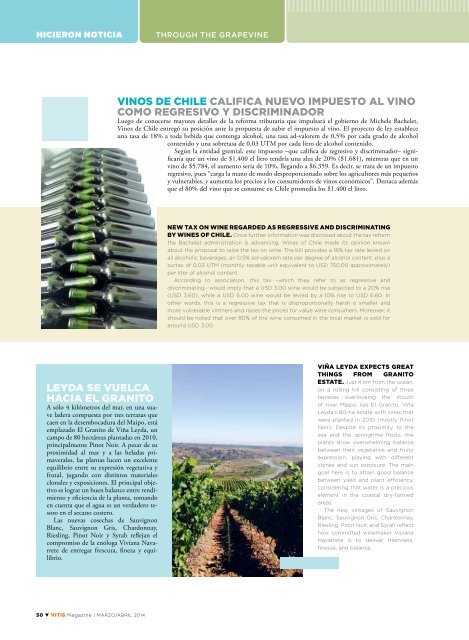rev_57
rev_57
rev_57
You also want an ePaper? Increase the reach of your titles
YUMPU automatically turns print PDFs into web optimized ePapers that Google loves.
hicieron noticia<br />
through the grapevine<br />
VINOS DE CHILE CALIFICA NUEVO IMPUESTO AL VINO<br />
COMO REGRESIVO Y DISCRIMINADOR<br />
Luego de conocerse mayores detalles de la reforma tributaria que impulsará el gobierno de Michele Bachelet,<br />
Vinos de Chile entregó su posición ante la propuesta de subir el impuesto al vino. El proyecto de ley establece<br />
una tasa de 18% a toda bebida que contenga alcohol, una tasa ad-valorem de 0,5% por cada grado de alcohol<br />
contenido y una sobretasa de 0,03 UTM por cada litro de alcohol contenido.<br />
Según la entidad gremial, este impuesto –que califica de regresivo y discriminador– significaría<br />
que un vino de $1.400 el litro tendría una alza de 20% ($1.681), mientras que en un<br />
vino de $5.784, el aumento sería de 10%, llegando a $6.359. Es decir, se trata de un impuesto<br />
regresivo, pues “carga la mano de modo desproporcionado sobre los agricultores más pequeños<br />
y vulnerables, y aumenta los precios a los consumidores de vinos económicos”. Destaca además<br />
que el 80% del vino que se consume en Chile promedia los $1.400 el litro.<br />
NEW TAX ON WINE REGARDED AS REGRESSIVE AND DISCRIMINATING<br />
BY WINES OF Chile. Once further information was disclosed about the tax reform<br />
the Bachelet administration is advancing, Wines of Chile made its opinion known<br />
about the proposal to raise the tax on wine. The bill provides a 18% tax rate levied on<br />
all alcoholic beverages, an 0.5% ad-valorem rate per degree of alcohol content, plus a<br />
surtax of 0.03 UTM (monthly taxable unit equivalent to USD 750.00 approximately)<br />
per liter of alcohol content.<br />
According to association, this tax –which they refer to as regressive and<br />
discriminating– would imply that a USD 3.00 wine would be subjected to a 20% rise<br />
(USD 3.60), while a USD 6.00 wine would be levied by a 10% rise to USD 6.60. In<br />
other words, this is a regressive tax that is disproportionally harsh o smaller and<br />
more vulnerable vintners and raises the prices for value wine consumers. Moreover, it<br />
should be noted that over 80% of the wine consumed in the local market is sold for<br />
around USD 3.00.<br />
LEYDA SE VUELCA<br />
HACIA EL GRANITO<br />
A sólo 4 kilómetros del mar, en una suave<br />
ladera compuesta por tres terrazas que<br />
caen en la desembocadura del Maipo, está<br />
emplazado El Granito de Viña Leyda, un<br />
campo de 80 hectáreas plantadas en 2010,<br />
principalmente Pinot Noir. A pesar de su<br />
proximidad al mar y a las heladas primaverales,<br />
las plantas lucen un excelente<br />
equilibrio entre su expresión vegetativa y<br />
frutal, jugando con distintos materiales<br />
clonales y exposiciones. El principal objetivo<br />
es lograr un buen balance entre rendimiento<br />
y eficiencia de la planta, tomando<br />
en cuenta que el agua es un verdadero tesoro<br />
en el secano costero.<br />
Las nuevas cosechas de Sauvignon<br />
Blanc, Sauvignon Gris, Chardonnay,<br />
Riesling, Pinot Noir y Syrah reflejan el<br />
compromiso de la enóloga Viviana Navarrete<br />
de entregar frescura, fineza y equilibrio.<br />
VIÑA LEYDA EXPECTS GREAT<br />
THINGS FROM GRANITO<br />
ESTATE. Just 4 km from the ocean,<br />
on a rolling hill consisting of three<br />
terraces overlooking the mouth<br />
of river Maipo, lies El Granito, Viña<br />
Leyda’s 80-ha estate with vines that<br />
were planted in 2010 (mostly Pinot<br />
Noir). Despite its proximity to the<br />
sea and the springtime frosts, the<br />
plants show overwhelming balance<br />
between their vegetative and fruity<br />
expression, playing with different<br />
clones and sun exposure. The main<br />
goal here is to attain good balance<br />
between yield and plant efficiency,<br />
considering that water is a precious<br />
element in the coastal dry-farmed<br />
areas.<br />
The new vintages of Sauvignon<br />
Blanc, Sauvignon Gris, Chardonnay,<br />
Riesling, Pinot Noir, and Syrah reflect<br />
how committed winemaker Viviana<br />
Navarrete is to deliver freshness,<br />
finesse, and balance.<br />
50 ▼ Vitis Magazine l marzo/abril 2014


